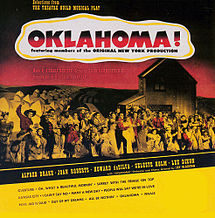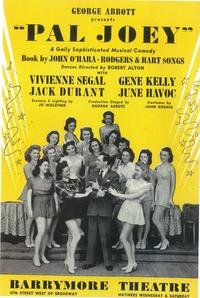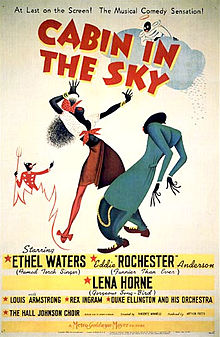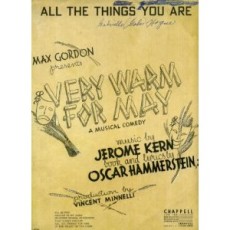
From Broadway To 52nd Street
The curtain rose on Oklahoma on the stage at the St. James Theatre on March 3, 1943. The cast consisted of Alfred Drake, Joan Roberts, Celeste Holm and Lee Dixon performing music and lyrics by Richard Rodgers and Oscar Hammerstein. Running 2,212 performances, the musical would go on to receive rave reviews as a film thirteen years later and str such greats as Shirley Jones, Gordon McRae, Rod Steiger and Eddie Albert. From the play came two songs that became jazz standards – People Will Say We’re In Love and The Surrey With The Fringe On Top.
The Story: The musical is about Laurie, a country girl, who is courted by a cowboy, Curly, and is pursued by the villain Jud, who also sees her as a love interest.
Broadway History: As change came to the Broadway play in the early 1940s, jazz musicians also sought change by looking for new directions to explore. A new style of jazz was born, called bebop. It had fast tempos, intricate melodies and complex harmonies. Bebop was considered jazz for intellectuals. The demise of the huge big bands was imminent to be replaced by smaller groups that did not play for dancing audiences but for listening audiences.
Sponsored By
www.whatissuitetabu.com
More Posts: broadway

From Broadway To 52nd Street
Lady In The Dark took the stage at the Alvin Theatre on January 23, 1941. The musical starred Gertrude Lawrence, McDonald Carey, Dianne Kaye and Victor Mature with the music composed by Kurt Weill and lyrics by Ira Gershwin. It ran for four hundred and sixty-seven performances. Beyond its Broadway run, Lady In The Dark would b staged in the United Kingdom in 1981, was also made into a 1944 film and a live 1954 television special. Except for the final song, all the music in the play is heard in three extended dream sequences: the Glamour Dream, the Wedding Dream, and the Circus Dream which, to some extent, become three small operettas integrated into a straight play. The final song, “My Ship”, which went on to become a jazz standard, functioned as a leitmotif for Liza’s insecurity: as each dream commences, a snippet of the tune is heard, as it is a haunting melody which Liza recognizes but cannot name, or sing with words, until her anxiety is resolved.
The Story: The protagonist, Liza Elliott, is the unhappy albeit successful editor of a fashion magazine, Allure, who is undergoing psychoanalysis. Relating a dream to her analyst, all the familiar male figures in her life appear in her dream but they act in unfamiliar ways. By recounting her dream, Liza realizes that her father’s disdain for her as a child has warped her relations with men.
Broadway History: Innovations to Broadway would come in 1943 with Rodgers & Hammerstein’s Oklahoma, which integrated music, song, and dance with a detailed plot. West Side Story followed in these footsteps in 1957 by introducing serious themes, causing the genre to be called simply “musicals”. In 1967 Hair would herald the rock musical to prominence.
Sponsored By
www.whatissuitetabu.com

From Broadway To 52nd Street
Pal Joey premiered at the Ethel Barrymore Theatre on December 25, 1940 and ran for 374 performances. Richard Rodgers and Lorenz Hart scored the music with the show starring Vivienne Segal, Gene Kelly, June Havoc, Jack Durant, Leila Ernst and Van Johnson. From the musical came the songs that rose to the roster of jazz classics I Could Write A Book, and Bewitched, Bothered and Bewildered.
The Story: Set in San Francisco, an irresistible heel named Joey Evans (Kelly) gets a job at the Mike’s Club, and becomes attracted to Linda English (Leila Ernst). Joey drops her for a rich, bewitched dowager Vera Simpson (Segal). Vera falls for Joey and builds him his own club, Chez Joey, but soon tires of him. With an encounter by blackmailers, (Durant & Havoc) Joey is off in search of other conquests. Unlike the movie version with Sinatra, Hayworth and Novak, the boy doesn’t get the girl in the end. This play marked the only Broadway musical that Kelly played a major role.
Broadway History: In the 18th century, Broadway ended at the town commons north of Wall Street Wall, where traffic continued up the East Side of the island via Eastern Post Road and the West Side via Bloomingdale Road. The western Bloomingdale Road would be widened and paved during the 19th century, and called “The Boulevard” north of Columbus Circle. On February 14, 1899. The name “Broadway” was extended to the entire Broadway/Bloomingdale/Boulevard Road.
Sponsored By
www.whatissuitetabu.com
More Posts: broadway

From Broadway To 52nd Street
Cabin In The Sky debuted on the Martin Beck Theatre stage on October 25, 1940. Running 156 performances, the show, directed by Albert Lewis and staged by George Balanchine, starred Ethel Waters, Dooley Wilson, Todd Duncan, Rex Ingram and Katherine Dunham. In 1943 it was turned into a silver screen classic with Vincente Minnelli directing Broadway stars Ethel Waters and Rex Ingram, along with Eddie “Rochester Anderson, Lena Horne and Louis Armstrong. The musical spawned such jazz classics as Taking A Chance On Love and Cabin In The Sky.
The Story: When a pious Petunia Jackson prays to the Good Lord to spare the life of her troublesome husband, Little Joe, the Good Lord allows Joe six months in which to redeem himself. He even sends the Lord’s General to help but has turned over a new leaf, he has an argument with Petunia and shoots her. They arrive at the Pearly Gates where Petunia’s loving pleas melt the Good Lord’s heart. So Joe is permitted to enter along with her.
Jazz History: Noted jazz disc jockey Symphony Sid frequently did live broadcasts from 52nd Street, making it famous across the country. By the late 1940s the jazz scene began moving elsewhere around the city and urban renewal took hold of the street. By the 1960s, most of the legendary clubs were razed or fell into disrepair. The last club there closed its doors in 1968.
Today, the street is full of banks, shops, and department stores and shows little trace of its jazz history. The block from 5th to 6th Avenues is formally co-named “Swing Street” and one block west is called “W. C. Handy’s Place”.
The 21 Club is the sole surviving club on 52nd Street that also existed during the 1940s. The venue for the original Birdland at 1674 Broadway located between 52nd & 53rd, which came into existence in 1949, is now a “Gentlemen’s Club”. The current Birdland is on 44th Street, between 8th and 9th Avenues.
Sponsored By
www.whatissuitetabu.com
More Posts: broadway

From Broadway To 52nd Street
Very Warm For May opened at the Alvin Theatre on November 17, 1939. Vincente Minnelli directed the play and the music was scored by Jerome Kern and Oscar Hammerstein, producing such favorites at the time as “All In Fun” and “In The Heart Of The Dark” but it was “All The Things You Are” that went on to become a jazz standard. However, the musical that starred June Allyson, Eve Arden and Vera-Ellen ran on Broadway for only two months, received mixed reviews and closed after only 59 performances.
The Story: The plot that had Long Island society girl May Graham fleeing threatening gangsters and hiding out with an avant-garde summer stock troupe in Connecticut. The first version of the show, which opened out of town, received rave reviews and played to sold-out houses. However, producer Max Gordon had been away when the show opened out of town and when he saw it, he hated the gangster subplot and had it removed. This could have been a contributing factor to the mixed reviews and the audience enjoyment.
Broadway History: Broadway was originally the Wickquasgeck Trail, carved into the brush destination of Manhattan by its indigenous Native American inhabitants.This trail originally snaked through swamps and rocks along the length of Manhattan Island.
Upon the arrival of the Dutch, the trail soon became the main road through the island from Nieuw Amsterdam at the southern tip. The Dutch explorer and entrepreneur David de Vries gives the first mention of the trail in his journal for the year 1642, “the Wickquasgeck Road over which the Indians passed daily”. Although current street signs are simply labeled as “Broadway”, in a 1776 map of New York City, Broadway is explicitly labeled “Broadway Street”.In the mid-eighteenth century, part of Broadway in what is now lower Manhattan was known as Great George Street.
Sponsored By
www.whatissuitetabu.com
More Posts: broadway


